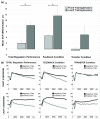Brain self-regulation in criminal psychopaths
- PMID: 25800672
- PMCID: PMC4371087
- DOI: 10.1038/srep09426
Brain self-regulation in criminal psychopaths
Abstract
Psychopathic individuals are characterized by impaired affective processing, impulsivity, sensation-seeking, poor planning skills and heightened aggressiveness with poor self-regulation. Based on brain self-regulation studies using neurofeedback of Slow Cortical Potentials (SCPs) in disorders associated with a dysregulation of cortical activity thresholds and evidence of deficient cortical functioning in psychopathy, a neurobiological approach seems to be promising in the treatment of psychopathy. The results of our intensive brain regulation intervention demonstrate, that psychopathic offenders are able to gain control of their brain excitability over fronto-central brain areas. After SCP self-regulation training, we observed reduced aggression, impulsivity and behavioral approach tendencies, as well as improvements in behavioral-inhibition and increased cortical sensitivity for error-processing. This study demonstrates improvements on the neurophysiological, behavioral and subjective level in severe psychopathic offenders after SCP-neurofeedback training and could constitute a novel neurobiologically-based treatment for a seemingly change-resistant group of criminal psychopaths.
Figures




Similar articles
-
Balancing the brain of offenders with psychopathy? Resting state EEG and electrodermal activity after a pilot study of brain self-regulation training.PLoS One. 2021 Jan 7;16(1):e0242830. doi: 10.1371/journal.pone.0242830. eCollection 2021. PLoS One. 2021. PMID: 33411746 Free PMC article.
-
Self-regulation of slow cortical potentials: a new treatment for children with attention-deficit/hyperactivity disorder.Pediatrics. 2006 Nov;118(5):e1530-40. doi: 10.1542/peds.2005-2478. Epub 2006 Oct 23. Pediatrics. 2006. PMID: 17060480
-
[From conduct disorder in childhood to psychopathy in adult life].Psychiatriki. 2012 Jun;23 Suppl 1:107-16. Psychiatriki. 2012. PMID: 22796980 Review. Greek, Modern.
-
Self-reported trauma, cortisol levels, and aggression in psychopathic and non-psychopathic prison inmates.Biol Psychol. 2008 Apr;78(1):75-86. doi: 10.1016/j.biopsycho.2007.12.011. Epub 2008 Jan 15. Biol Psychol. 2008. PMID: 18304719
-
[Psychopathy in forensic psychiatry].Fortschr Neurol Psychiatr. 2001 Dec;69(12):603-10. doi: 10.1055/s-2001-19182. Fortschr Neurol Psychiatr. 2001. PMID: 11753750 Review. German.
Cited by
-
Balancing the brain of offenders with psychopathy? Resting state EEG and electrodermal activity after a pilot study of brain self-regulation training.PLoS One. 2021 Jan 7;16(1):e0242830. doi: 10.1371/journal.pone.0242830. eCollection 2021. PLoS One. 2021. PMID: 33411746 Free PMC article.
-
How standardized are "standard protocols"? Variations in protocol and performance evaluation for slow cortical potential neurofeedback: A systematic review.Front Hum Neurosci. 2022 Sep 2;16:887504. doi: 10.3389/fnhum.2022.887504. eCollection 2022. Front Hum Neurosci. 2022. PMID: 36118975 Free PMC article.
-
Altered power spectra in antisocial males during rest as a function of cocaine dependence: A network analysis.Psychiatry Res Neuroimaging. 2021 Mar 30;309:111235. doi: 10.1016/j.pscychresns.2020.111235. Epub 2020 Dec 11. Psychiatry Res Neuroimaging. 2021. PMID: 33484936 Free PMC article.
-
Alpha activity neuromodulation induced by individual alpha-based neurofeedback learning in ecological context: a double-blind randomized study.Sci Rep. 2021 Sep 16;11(1):18489. doi: 10.1038/s41598-021-96893-5. Sci Rep. 2021. PMID: 34531416 Free PMC article. Clinical Trial.
-
What makes a "successful" psychopath? Longitudinal trajectories of offenders' antisocial behavior and impulse control as a function of psychopathy.Personal Disord. 2021 May;12(3):207-215. doi: 10.1037/per0000421. Epub 2020 Jun 25. Personal Disord. 2021. PMID: 32584094 Free PMC article.
References
-
- Hare R. D. Hare Psychopathy Checklist-Revised (Multi-Health Systems, 2003).
-
- Newman J. P. & Wallace J. F. Diverse pathways to deficient self-regulation: implications for disinhibitory psychopathology in children. Annu. Rev. Clin. Psychol. 13, 699–720 (1993).
-
- Carver C. S. & Harmon-Jones E. Anger is an approach-related affect: evidence and implications. Psychol. Bull. 135, 183–204 (2009). - PubMed
-
- Harmon-Jones E. & Peterson C. K. Effect of trait and state approach motivation on aggressive inclinations. J. Res. Pers. 42, 1381–85 (2008).
-
- Blair R. J. R. et al. Passive avoidance learning in individuals with psychopathy: modulation by reward but not by punishment. J. Individ. Differ. 37, 1179–92 (2004).
Publication types
MeSH terms
LinkOut - more resources
Full Text Sources
Other Literature Sources

